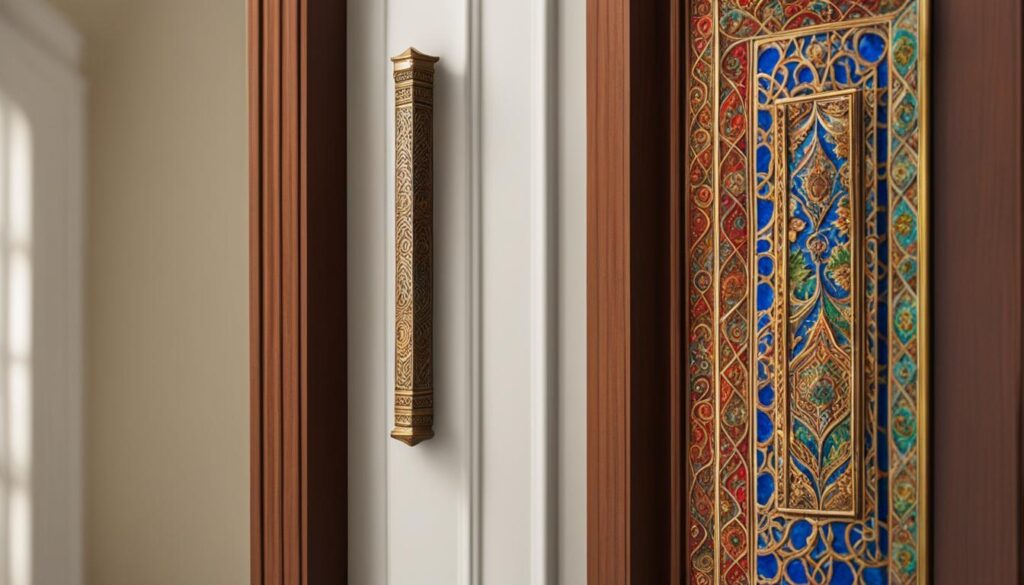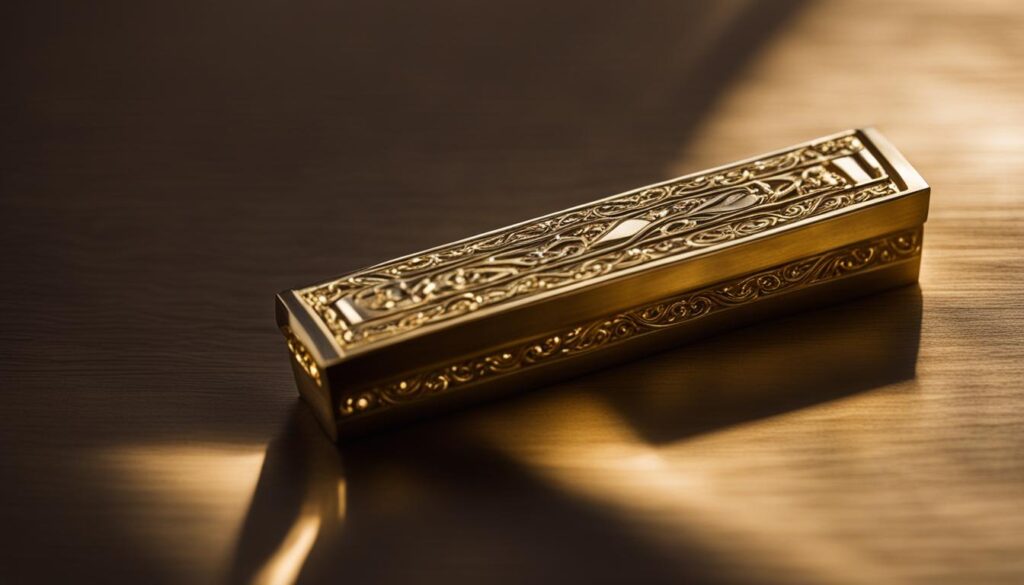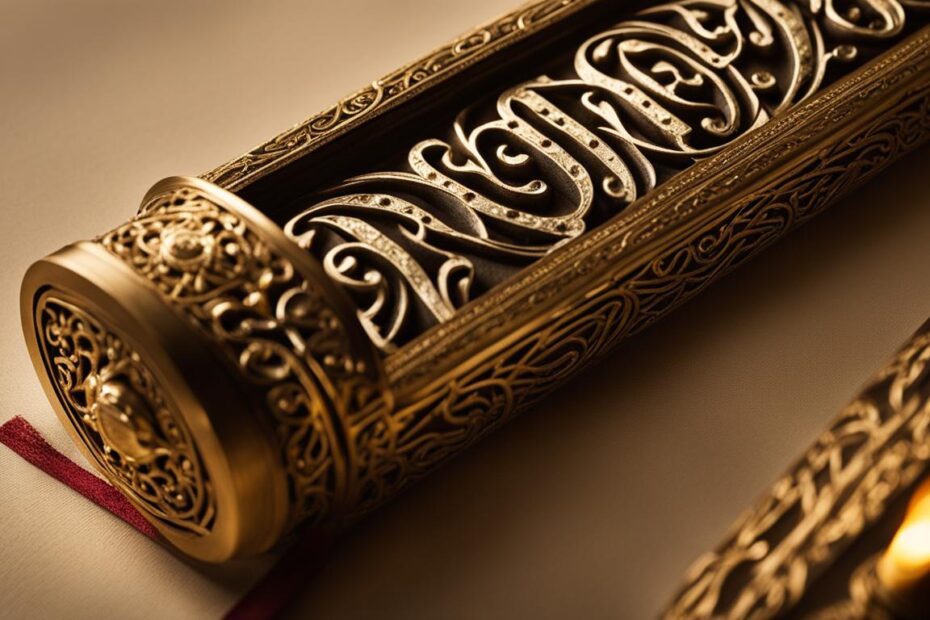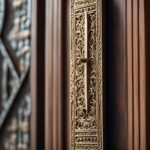A mezuzah is a small box placed on the doorposts of Jewish homes. It contains a special scroll made of parchment with passages from the Torah written on it. The most important prayer found in a mezuzah is called the “Shema Yisrael,” which expresses belief in one God.
Key Takeaways:
- The mezuzah is a small box placed on the doorposts of Jewish homes. Inside, it contains a scroll made of parchment with prayers written on it.
- The most important prayer found in a mezuzah is the “Shema Yisrael,” which expresses belief in one God.
- The mezuzah serves as a reminder of God’s commandments and is believed to provide protection and ward off negative influences.
- An authentic mezuzah requires a certified kosher scroll written by a professional scribe.
- Mezuzahs are traditionally affixed on the right side of every doorpost, except for bathrooms, and are positioned at shoulder height or within the lower and upper thirds of the doorpost.
The Significance of Mezuzahs in Jewish Traditions
Mezuzahs hold great religious and cultural significance in Jewish traditions. These small boxes, affixed to the doorposts of Jewish homes, symbolize several core principles of Judaism. They serve as reminders of God’s commandments and express the belief in one God. The mezuzah is not just a decorative item; it is a powerful symbol that holds deep meaning for Jewish households.
The importance of mezuzahs extends beyond their decorative value. They are believed to provide protection and ward off negative influences. They serve as constant reminders of God’s presence and His covenant with the Jewish people. The mezuzah stands as a tangible representation of faith and a visible declaration of one’s commitment to God’s commandments.
“The mezuzah signifies the importance of our faith and serves as a daily reminder of our commitment to living a righteous life,” explains Rabbi David Cohen, a recognized authority on Jewish traditions. “It is a symbol that connects us to our heritage and reinforces our spiritual connection to God.”
The mezuzah signifies the importance of our faith and serves as a daily reminder of our commitment to living a righteous life. It is a symbol that connects us to our heritage and reinforces our spiritual connection to God.
The Spiritual Significance
Beyond its physical presence, the mezuzah holds spiritual significance in Jewish traditions. It is believed to create a sacred space within the home, connecting the inhabitants to a higher spiritual realm. The act of touching and kissing the mezuzah upon entering or leaving the house is seen as a way to acknowledge God’s presence and seek His blessings.
“The mezuzah serves as a gateway, inviting divine protection and blessings into the home,” says Rabbi Cohen. “It serves as a constant reminder of our connection to God and our duty to live a life guided by His commandments.”
| Significance of Mezuzahs in Jewish Traditions | Summary |
|---|---|
| The mezuzah symbolizes core principles of Judaism and represents a commitment to God’s commandments. | The mezuzah is a powerful symbol that holds deep meaning for Jewish households, serving as a reminder of God’s presence and His covenant with the Jewish people. |
| Mezuzahs provide protection and ward off negative influences. | Mezuzahs are believed to offer divine protection and serve as a tangible representation of faith. |
| Mezuzahs create a sacred space within the home and invite divine blessings. | The act of touching and kissing the mezuzah is seen as a way to acknowledge God’s presence and seek His blessings. |
The mezuzah and its significance in Jewish traditions go far beyond a mere decorative item. It is a symbol that connects believers to their faith, reinforcing their spiritual connection to God and serving as a constant reminder of their commitment to living a righteous life.
Exploring the Historical Origins of Mezuzahs
The mezuzah, with its rich history and symbolism, has intrigued scholars for centuries. Its origins can be traced back to biblical times, where the term “mezuzah” referred to doorposts. The debate surrounding its roots continues, with some attributing it to the Hebrew root “z-u-z,” signifying motion, while others connect it to the Akkadian term “mazzazu,” meaning stand.
Originally, mezuzahs served as educational reminders of God’s commandments. The Torah instructs Jewish believers to write these commandments on their doorposts and gates, keeping them ever-present in their lives. Over time, the mezuzah evolved into more than just an educational tool; it became an apotropaic device, believed to protect homes from impurities and evil forces.
The mezuzah’s transformation reflects its historical journey. From a simple reminder to a powerful symbol of faith and protection, it embodies the enduring connection between Jewish believers and their devotion to God.

The Ancient Origins of Mezuzahs
While the exact origins of the mezuzah remain debatable, its significance and religious importance cannot be denied. The tradition of affixing a mezuzah to doorposts has been passed down through generations, ensuring its continued presence in Jewish homes.
As with many religious practices, the mezuzah carries layers of meaning and symbolism. It serves as a constant reminder of God’s commandments and a tangible expression of faith. The act of touching the mezuzah upon entering or leaving a room serves as a physical connection to one’s religious beliefs and the larger Jewish community.
Today, the mezuzah continues to be an integral part of Jewish life, bridging the gap between past and present, and serving as a testament to the enduring nature of faith.
The Shema Yisrael – The Most Important Prayer in a Mezuzah
The mezuzah scroll contains several passages from the Torah, but the most important prayer found inside is the Shema Yisrael. This prayer holds significant religious and spiritual importance in Judaism and serves as a declaration of faith in one God.
The Shema Yisrael is a powerful affirmation of monotheism and is recited by Jews daily. It begins with the words “Shema Yisrael,” which translates to “Hear, O Israel,” and is followed by the proclamation, “The Lord our God, the Lord is one.” This statement emphasizes the belief in the singularity and oneness of God.
“Hear, O Israel:
The Lord our God, the Lord is one.” – Deuteronomy 6:4
The Shema Yisrael represents not only a declaration of faith but also a call to action. It urges individuals to love and serve God with their whole being and to teach these principles diligently to their children, as stated in the following passage from Deuteronomy:
“These commandments that I give you today are to be on your hearts. Impress them on your children. Talk about them when you sit at home and when you walk along the road, when you lie down and when you get up.” – Deuteronomy 6:6-7
By having the Shema Yisrael prayer inside a mezuzah, Jewish households are reminded of their commitment to God and His commandments. It serves as a constant reminder of their faith and belief in the one true God.
| Verse | Translation |
|---|---|
| Shema Yisrael | Hear, O Israel |
| Adonai Eloheinu | The Lord our God |
| Adonai Echad | The Lord is one |
Authenticity and the Writing of Mezuzah Scrolls

An authentic mezuzah requires a certified kosher scroll written by a professional scribe, known as a sofer. Hand-written scrolls demand meticulous attention to detail, as even one misplaced or poorly formed letter can render the whole scroll invalid. Observant followers believe that an inauthentic or defective mezuzah lacks religious validity and might deny them divine protection.
The process of writing a mezuzah scroll is governed by specific requirements to ensure its authenticity. The sofer must be well-versed in the laws and techniques of writing a kosher mezuzah. The scroll is typically written on high-quality parchment using a special quill pen and black ink. The scribe must write each letter and word with utmost precision and focus, observing the established traditions and guidelines.
Once the scroll is complete, it is rolled up and placed inside a mezuzah case, ensuring that the sacred text faces inward. The case itself is often ornate and can be made from various materials, such as metal, wood, or glass. The mezuzah scroll is then affixed to the doorpost of a Jewish home, symbolizing the occupants’ commitment to following God’s commandments and inviting divine protection into their lives.
The Importance of Authentic Mezuzah Scrolls
The authenticity of the mezuzah scroll is of utmost importance in Jewish tradition. The meticulous process of writing the scroll by a professional scribe ensures that every word is transcribed correctly, maintaining the integrity of the sacred text. This attention to detail reflects the reverence and respect for God’s commandments and reinforces the belief that an authentic mezuzah carries spiritual significance and divine protection.
| Authentic Mezuzah Scroll | Inauthentic Mezuzah Scroll |
|---|---|
| Written by a certified scribe (sofer) | Not written by a certified scribe (sofer) |
| Every letter and word written with precision | Potential errors or omissions in the text |
| Transcribed on high-quality parchment | Lower-quality materials used for the scroll |
| Invites divine protection and spiritual blessings | May lack religious validity and divine significance |
The Placement and Positioning of Mezuzahs
Proper placement and positioning of mezuzahs are important aspects of Jewish tradition and observance. Mezuzahs are traditionally affixed on the right side of every doorpost in Jewish homes, excluding bathrooms. The purpose of placing a mezuzah on the doorpost is to serve as a constant reminder of God’s commandments and to invite divine protection into the household.
When affixing a mezuzah, it is recommended to position it at shoulder height or somewhere within the lower and upper thirds of the doorpost. This specific height consideration stems from the understanding that the mezuzah should be easily visible and accessible for individuals to touch and kiss when entering or leaving the room. It symbolizes an active engagement with the faith and a personal connection to God’s commandments.
When moving into a new dwelling, it is customary to affix the mezuzah within 30 days. This timeframe allows individuals to prioritize the observance of this significant commandment while settling into their new home. By promptly fulfilling this tradition, individuals affirm their commitment to their faith and create an environment that is permeated with spirituality.

Table: Proper Placement and Positioning of Mezuzahs
| Location | Height Consideration |
|---|---|
| Main Entrance | Shoulder height or within the lower and upper thirds of the doorpost |
| Other Rooms | Shoulder height or within the lower and upper thirds of the doorpost |
| Bathrooms | Excluded from mezuzah placement |
By adhering to the proper placement and positioning of mezuzahs, individuals honor their faith and create a sacred atmosphere within their homes. The mezuzah serves as a physical and tangible representation of their commitment to God’s commandments, reminding them of their spiritual obligations and inviting blessings into their lives.
The Aaronic Blessing and its Connection to Mezuzahs
The Aaronic blessing, also known as the Priestly Blessing, holds a significant place in Jewish tradition and is often connected to the tradition of mezuzahs. This ancient blessing is found in the Book of Numbers (6:24-26) and is recited by Kohanim, descendants of Aaron, during certain religious ceremonies.
The Aaronic blessing is a prayer for God’s presence, protection, and peace. It consists of three parts:
- May the Lord bless you and keep you;
- May the Lord make His face shine upon you and be gracious to you;
- May the Lord lift up His countenance upon you and give you peace.
This blessing is deeply intertwined with the symbolism and purpose of the mezuzah. It represents an invitation and a desire to honor God in one’s home, seeking His presence, protection, and peace. Just as the mezuzah serves as a physical reminder of God’s commandments, the Aaronic blessing serves as a spiritual reminder of God’s favor and blessings upon His people.
| Symbolism | Meaning |
|---|---|
| The Lord bless you and keep you | God’s watchful care and protection |
| The Lord make His face shine upon you and be gracious to you | God’s favor and grace |
| The Lord lift up His countenance upon you and give you peace | God’s presence and peace |
The Aaronic blessing is a beautiful expression of the desire for divine favor and peace. When recited, it serves as a powerful reminder of God’s love and protection in our lives. Through the mezuzah, this blessing becomes ingrained in the daily lives of Jewish households, creating a tangible connection to God’s presence and peace.

As believers affix the mezuzah to their doorposts and recite the Aaronic blessing, they not only embrace their faith but also create a sacred space within their homes. This connection between the mezuzahs and the Aaronic blessing strengthens the bond between God and His people, fostering an environment of spiritual growth, protection, and peace.
The Face-to-Face Encounter in the Secret Place
In the realm of spirituality, there is a longing for a deep and personal connection with a higher power. Many individuals seek a face-to-face encounter with God, a moment where they can meet Him in the Secret Place and experience His presence in a profound way.
Meeting God in the Secret Place is a desire shared by believers across various faith traditions. It represents an intimate and transformative experience where one can commune with the divine and find solace, guidance, and renewal. In this sacred space, individuals can lay bare their fears, hopes, and dreams, knowing that they are seen and heard by a loving and compassionate Creator.
The presence of God in the Secret Place is not confined to a physical location or a specific set of religious practices. It transcends earthly boundaries and dwells within the hearts and minds of those who seek Him. It is a spiritual journey that requires stillness, reflection, and an openness to receiving divine revelation. In this encounter, individuals may experience a profound sense of peace, clarity, and purpose, knowing that they are deeply known and loved by their Creator.

Quote:
“In the Secret Place, we are invited to come as we are, to pour out our hearts and souls before God. It is a sacred space where He meets us, listens to our prayers, and guides us on our journey of faith.” – Anonymous
Conclusion
In conclusion, mezuzahs play a significant role in Jewish traditions, symbolizing core principles and serving as reminders of God’s commandments. The prayer scroll inside a mezuzah holds the powerful Shema Yisrael, which reinforces belief in one God and holds paramount importance in Judaism. It is essential to ensure the authenticity of the mezuzah scroll, as a certified kosher scroll written by a professional scribe is necessary for religious validity.
The placement and positioning of the mezuzah on doorposts follow specific guidelines, reflecting the reverence and honor bestowed upon God’s presence. The Aaronic blessing, intricately connected to the mezuzah tradition, invites God’s blessing, protection, and peace into Jewish homes, aligning with the mezuzah’s symbolism and purpose.
Ultimately, the mezuzah and its prayers encourage individuals to seek intimate encounters with God in the Secret Place, where His presence brings wholeness and spiritual fulfillment. The mezuzah stands as a testament to faith, culture, and a profound connection to the divine.
FAQ
What prayer is inside a mezuzah?
The most important prayer found in a mezuzah is called the “Shema Yisrael,” which expresses belief in one God.
What is the significance of mezuzahs in Jewish traditions?
Mezuzahs serve as reminders of God’s commandments, provide protection, and symbolize several core principles of Judaism.
What are the historical origins of mezuzahs?
The term “mezuzah” originally referred to doorposts in biblical times, and over time, they evolved from educational reminders to apotropaic devices.
What is the Shema Yisrael?
The Shema Yisrael is the most important prayer found in a mezuzah, asserting monotheism and belief in one God.
How are mezuzah scrolls authenticated?
Authentic mezuzah scrolls require a certified kosher scroll written by a professional scribe, known as a sofer.
Where should mezuzahs be placed?
Mezuzahs are traditionally affixed on the right side of every doorpost in Jewish homes (except for bathrooms) at shoulder height or within the lower and upper thirds of the doorpost.
What is the connection between mezuzahs and the Aaronic Blessing?
The Aaronic Blessing, found in the Book of Numbers, is often associated with the tradition of mezuzahs as a prayer for God’s presence, protection, and peace.
What is the significance of the face-to-face encounter in the Secret Place?
The face-to-face encounter with God is a desire for intimate connection and wholeness in His presence, paralleling the purpose and symbolism of the mezuzah.








